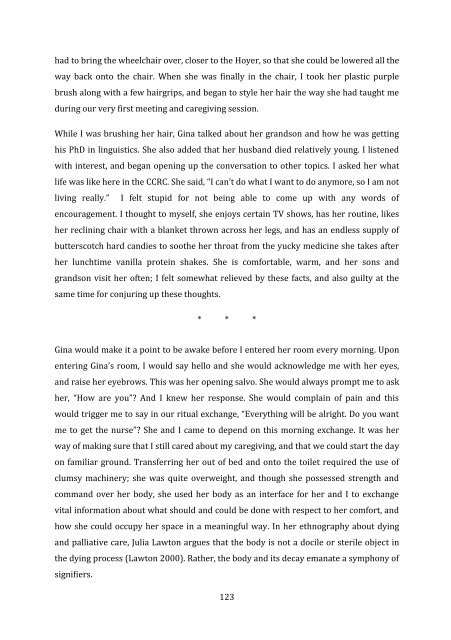Philip Y. Kao PhD thesis - Research@StAndrews:FullText
Philip Y. Kao PhD thesis - Research@StAndrews:FullText
Philip Y. Kao PhD thesis - Research@StAndrews:FullText
You also want an ePaper? Increase the reach of your titles
YUMPU automatically turns print PDFs into web optimized ePapers that Google loves.
had to bring the wheelchair over, closer to the Hoyer, so that she could be lowered all the<br />
way back onto the chair. When she was finally in the chair, I took her plastic purple<br />
brush along with a few hairgrips, and began to style her hair the way she had taught me<br />
during our very first meeting and caregiving session.<br />
While I was brushing her hair, Gina talked about her grandson and how he was getting<br />
his <strong>PhD</strong> in linguistics. She also added that her husband died relatively young. I listened<br />
with interest, and began opening up the conversation to other topics. I asked her what<br />
life was like here in the CCRC. She said, “I can’t do what I want to do anymore, so I am not<br />
living really.” I felt stupid for not being able to come up with any words of<br />
encouragement. I thought to myself, she enjoys certain TV shows, has her routine, likes<br />
her reclining chair with a blanket thrown across her legs, and has an endless supply of<br />
butterscotch hard candies to soothe her throat from the yucky medicine she takes after<br />
her lunchtime vanilla protein shakes. She is comfortable, warm, and her sons and<br />
grandson visit her often; I felt somewhat relieved by these facts, and also guilty at the<br />
same time for conjuring up these thoughts.<br />
* * *<br />
Gina would make it a point to be awake before I entered her room every morning. Upon<br />
entering Gina’s room, I would say hello and she would acknowledge me with her eyes,<br />
and raise her eyebrows. This was her opening salvo. She would always prompt me to ask<br />
her, “How are you”? And I knew her response. She would complain of pain and this<br />
would trigger me to say in our ritual exchange, “Everything will be alright. Do you want<br />
me to get the nurse”? She and I came to depend on this morning exchange. It was her<br />
way of making sure that I still cared about my caregiving, and that we could start the day<br />
on familiar ground. Transferring her out of bed and onto the toilet required the use of<br />
clumsy machinery; she was quite overweight, and though she possessed strength and<br />
command over her body, she used her body as an interface for her and I to exchange<br />
vital information about what should and could be done with respect to her comfort, and<br />
how she could occupy her space in a meaningful way. In her ethnography about dying<br />
and palliative care, Julia Lawton argues that the body is not a docile or sterile object in<br />
the dying process (Lawton 2000). Rather, the body and its decay emanate a symphony of<br />
signifiers.<br />
123
















